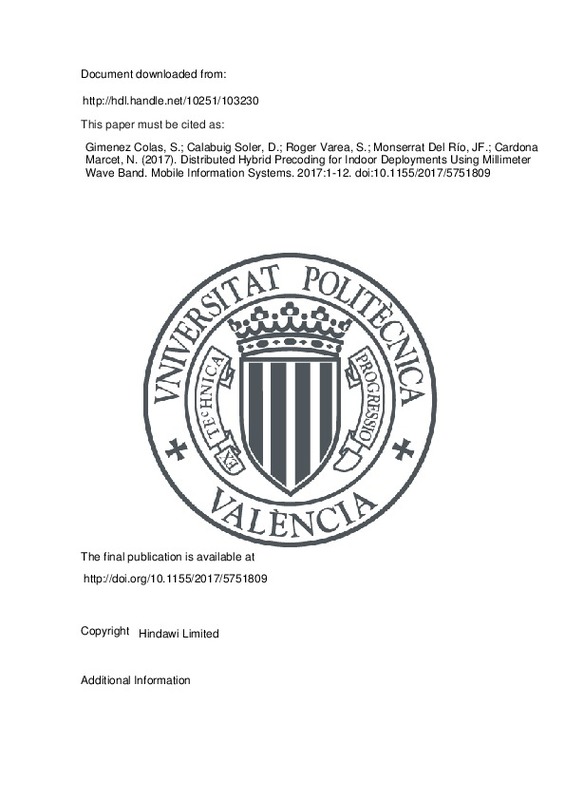JavaScript is disabled for your browser. Some features of this site may not work without it.
Buscar en RiuNet
Listar
Mi cuenta
Estadísticas
Ayuda RiuNet
Admin. UPV
Distributed Hybrid Precoding for Indoor Deployments Using Millimeter Wave Band
Mostrar el registro sencillo del ítem
Ficheros en el ítem
| dc.contributor.author | Giménez Colás, Sonia
|
es_ES |
| dc.contributor.author | Calabuig Soler, Daniel
|
es_ES |
| dc.contributor.author | Roger Varea, Sandra
|
es_ES |
| dc.contributor.author | Monserrat del Río, José Francisco
|
es_ES |
| dc.contributor.author | Cardona Marcet, Narciso
|
es_ES |
| dc.date.accessioned | 2018-06-02T04:20:02Z | |
| dc.date.available | 2018-06-02T04:20:02Z | |
| dc.date.issued | 2017 | es_ES |
| dc.identifier.issn | 1574-017X | es_ES |
| dc.identifier.uri | http://hdl.handle.net/10251/103230 | |
| dc.description.abstract | [EN] DistributedAntenna Systems (DAS) are an alternative of network deployment that allows reducing the distance between transmitter and receiver by distributing the antennas throughout the coverage area. Moreover, the performance of the millimeter wave (mmWave) band can be significantly high within short transmitter-receiver distances. In this paper, the potential benefits of DAS deployments in the mmWave band are studied. To this aim, a distributed hybrid precoding (DHP) solution with remote antenna unit (RAU) selection capabilities is proposed and analyzed in an indoor DAS working in mmWaves and compared to two other indoor deployment strategies: a conventional cellular system with colocated antenna arrays and a small cell deployment. Theresults show that, using DHP, DAS not only brings huge gains to cell-edge users rate but also increases system capacity, becoming the best overall deployment. Further simulations including practical limitations have revealed that DAS using DHP is quite robust to combiner losses, although its performance is significantly degraded by outdated channel reports. | es_ES |
| dc.description.sponsorship | This work has been supported by Ministerio de Economia y Competitividad, Spain (BES-2012-055975 and TEC2014-60258-C2-1-R), and by the European FEDER funds. | es_ES |
| dc.language | Inglés | es_ES |
| dc.publisher | Hindawi Limited | es_ES |
| dc.relation.ispartof | Mobile Information Systems | es_ES |
| dc.rights | Reserva de todos los derechos | es_ES |
| dc.subject | Antenna systems | es_ES |
| dc.subject | Mobile communications | es_ES |
| dc.subject | Downlink | es_ES |
| dc.subject | 5G | es_ES |
| dc.subject | Performance | es_ES |
| dc.subject | Capacity | es_ES |
| dc.subject.classification | TEORIA DE LA SEÑAL Y COMUNICACIONES | es_ES |
| dc.title | Distributed Hybrid Precoding for Indoor Deployments Using Millimeter Wave Band | es_ES |
| dc.type | Artículo | es_ES |
| dc.identifier.doi | 10.1155/2017/5751809 | es_ES |
| dc.relation.projectID | info:eu-repo/grantAgreement/MINECO//TEC2014-60258-C2-1-R/ES/DESARROLLO DE ARQUITECTURAS Y TECNOLOGIAS FUTURAS HACIA LA RED 5G/ | es_ES |
| dc.relation.projectID | info:eu-repo/grantAgreement/MINECO//BES-2012-055975/ES/BES-2012-055975/ | es_ES |
| dc.rights.accessRights | Abierto | es_ES |
| dc.contributor.affiliation | Universitat Politècnica de València. Departamento de Comunicaciones - Departament de Comunicacions | es_ES |
| dc.contributor.affiliation | Universitat Politècnica de València. Instituto Universitario de Telecomunicación y Aplicaciones Multimedia - Institut Universitari de Telecomunicacions i Aplicacions Multimèdia | es_ES |
| dc.description.bibliographicCitation | Giménez Colás, S.; Calabuig Soler, D.; Roger Varea, S.; Monserrat Del Río, JF.; Cardona Marcet, N. (2017). Distributed Hybrid Precoding for Indoor Deployments Using Millimeter Wave Band. Mobile Information Systems. 2017:1-12. https://doi.org/10.1155/2017/5751809 | es_ES |
| dc.description.accrualMethod | S | es_ES |
| dc.relation.publisherversion | http://doi.org/10.1155/2017/5751809 | es_ES |
| dc.description.upvformatpinicio | 1 | es_ES |
| dc.description.upvformatpfin | 12 | es_ES |
| dc.type.version | info:eu-repo/semantics/publishedVersion | es_ES |
| dc.description.volume | 2017 | es_ES |
| dc.relation.pasarela | S\351647 | es_ES |
| dc.contributor.funder | Ministerio de Economía, Industria y Competitividad | es_ES |







![[Cerrado]](/themes/UPV/images/candado.png)

